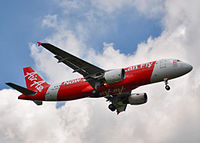
Photo from wikipedia
Surface air temperature is an essential variable for monitoring the atmosphere, and it is generally acquired at meteorological stations that can provide information about only a small area within an… Click to show full abstract
Surface air temperature is an essential variable for monitoring the atmosphere, and it is generally acquired at meteorological stations that can provide information about only a small area within an r m radius (r-neighborhood) of the station, which is called the representable radius. In studies on a local scale, ground-based observations of surface air temperatures obtained from scattered stations are usually interpolated using a variety of methods without ascertaining their effectiveness. Thus, it is necessary to evaluate the spatial representativeness of ground-based observations of surface air temperature before conducting studies on a local scale. The present study used remote sensing data to estimate the spatial distribution of surface air temperature using the advection-energy balance for air temperature (ADEBAT) model. Two target stations in the study area were selected to conduct an analysis of spatial representativeness. The results showed that one station (AWS 7) had a representable radius of about 400 m with a possible error of less than 1 K, while the other station (AWS 16) had the radius of about 250 m. The representable radius was large when the heterogeneity of land cover around the station was small.
Journal Title: Theoretical and Applied Climatology
Year Published: 2017
Link to full text (if available)
Share on Social Media: Sign Up to like & get
recommendations!